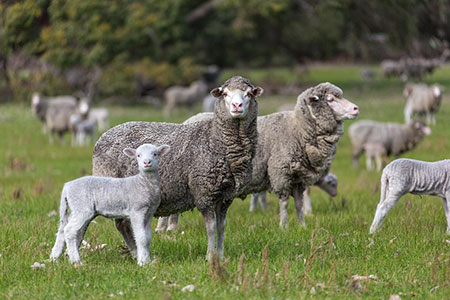Lamb survival and performance are strongly aligned with the lactation of the ewe. The ewe’s ability to raise a lamb is strongly aligned with her energy and protein requirements and the more lambs she has, the greater her energy requirements. Meeting the energy requirements of the ewe can be challenging on pasture alone and becomes even more so in times where rainfall has not been optimal. The ewe not only needs a good quantity of feed but the quality of that feed must be optimal to support lactation and minimise weight loss.
Pasture targets for ewes with singles should be a minimum of 1200kg DM/ha of high quality pasture and ewes with twins should have a minimum of 1500 kg
DM/ha of high quality pasture. Studies have demonstrated that ewes suckling twins will produce approximately 40% more milk than a ewe suckling a single
lambs. Pastures should also comprise of a minimum of 20% legume to support the protein needs of lactating ewes. Research has demonstrated that not
meeting the protein requirement of lactating ewes not only impacts milk production but makes them more susceptible to worm burdens.
If no paddock feed is available full hand feeding will be required either in a sacrifice paddock or confinement feeding situation. In this situation it is important that all the ewes’ requirements are met. An example full ration for a ewe with a 2 month old lamb at foot would require a weekly ration of 2.1kg of hay + 6.6 kg barley + 1 kg of lupins. For further details refer to ‘Feeding and Managing Sheep in Dry Times’ bulletin or consult your nutritionist for specific recommendations.
Hypocalcaemia or milk fever is not usually common in lactating ewes. It generally occurs during late pregnancy coinciding with pregnancy toxaemia. However it can be a problem within lactating flocks under certain conditions. Hypomagnesaemia also known as grass tetany is also not common in ewes but can be a problem in individual flocks if ewes are being underfed. It also may occur if pastures have been heavily fertilized, particularly with potassium.
Weaning at the optimal time is important for ewes particularly in years that are poor and pasture availability is limited. Weaning at 12 to 14 weeks from the start of lambing assuming the joining period is not greater than 6 weeks is ideal. Longer joining periods may require considerations for later born lambs. Delaying weaning will mean that ewes will have less opportunity to regain any condition lost particularly if they have experience significant weight loss during lactation before the next joining.
Condition score has a significant influence over successful conception of the ewe. Poor condition score of the ewe at joining will reduce reproductive performance and impact on production next year. The Lifetime Wool project demonstrated an increase of about 20% extra lambs for each rise in condition score at joining. This impact is compounded in poorer seasons and with ewes that have raised multiple lambs. Wool production will also be compromised in ewes with poor condition.
If ewes are below condition score 3 at weaning they should be drafted and managed separately by placing on high quality pastures if available or given supplementary feed.
Further detail is available on the SheepConnect SA webinar ‘Ewe nutrition & health’
Photo: Courtesy DAFWA
By Tiffany Bennett, Livestock Consultant, PIRSA Rural Solutions





